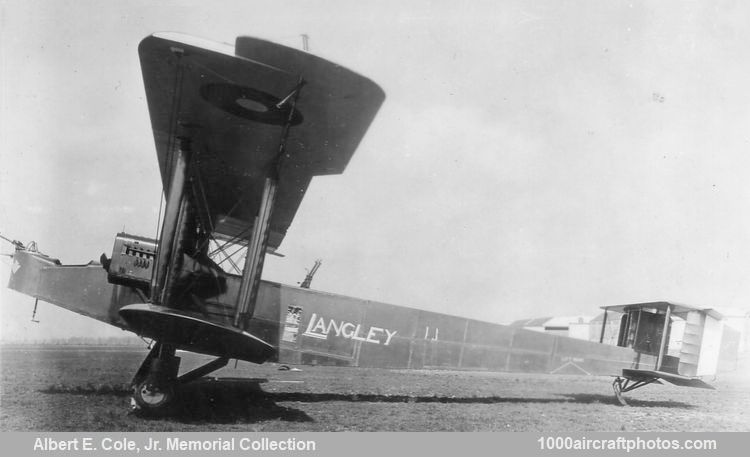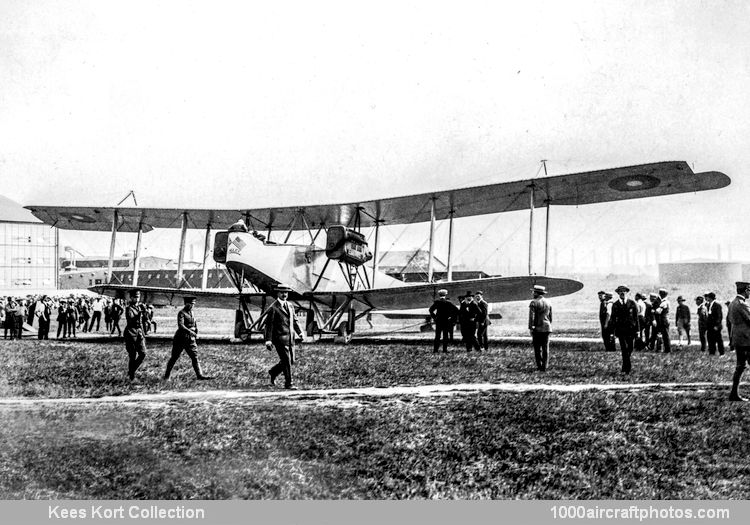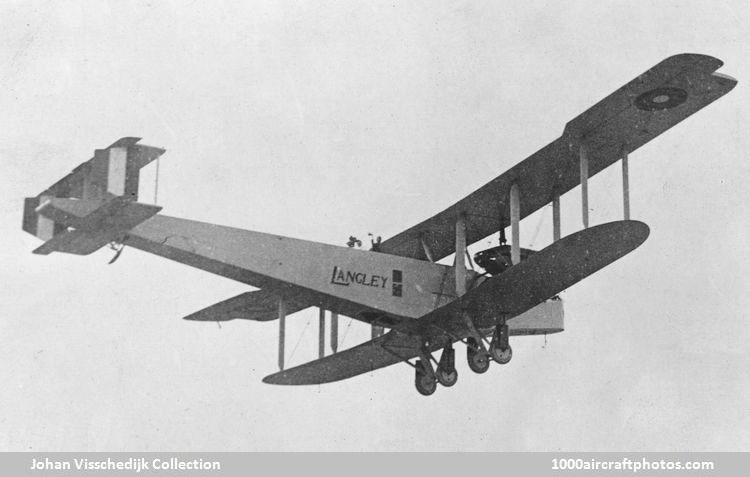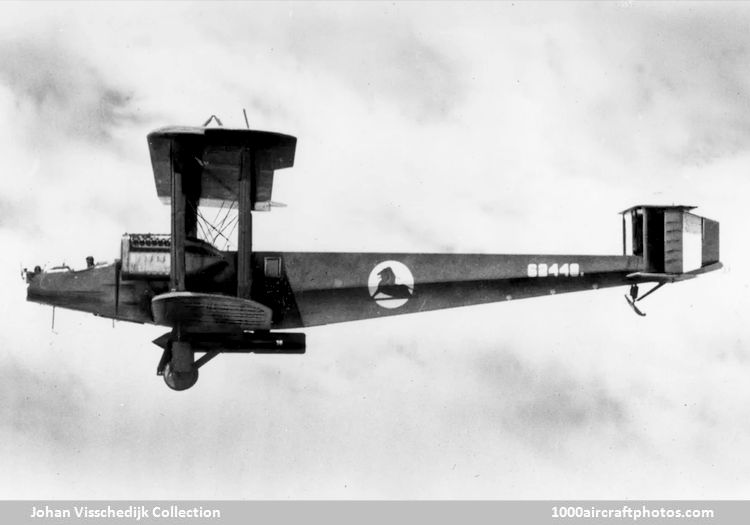ALBERT E. COLE JR. MEMORIAL COLLECTION
No. 14097. Handley Page H.P.12 O/400 US Army Air Service "Langley"
05/15/2022. Remarks by
Johan Visschedijk: "The O/400 was one of the only two European multi-engined bombers selected for mass production in America after the United States joined the Allies in April 1917, the other being the Caproni Ca.5. In August a set of O/400 drawings was sent to McCook Field, Dayton, Ohio, where the US Signals Corps Engineering Division designed a modification scheme to substitute the new 400 hp Liberty 12N engines for the 360 hp Rolls-Royce Eagle VIII engines, both were twelve-cylinder liquid-cooled V-types. The O/400 was strong enough to accept this engine change with advantage. In January 1918 a sample airframe was shipped to McCook Field; this was in fact B9449, an 'intermediate' O/100 in which most parts were the same as in O/400, those which were different being painted red.
The Standard Aircraft Corporation of Elizabeth, New Jersey, had received an order for 500 O/400s (serialed 62445 to 62944), for which parts were to be produced by other companies. Standard would assemble fifty aircraft and ship 450 sets of components (each 85% complete) to England for assembly in the Manchester area. The first O/400 to emerge from the Standard Corporation factory made its maiden flight on July 1, 1918, flown by RAF pilots Colonel William Semphill (the 19th Lord of Semphill) and Captain E.B. Waller.
The first O/400 named "Langley" with running engines (
Kees Kort Collection)
On July 6, 1918, in the presence of over 5,000 spectators, including many civil and military VIPs from the USA, UK and Canada, as well as most of the manufacturer's work force, the first O/400 was ceremonially christened "Langley". Finished with clear varnish, it had the name "Langley" painted on each flank and also across the nose, together with crossed British Union Jack and American Old Glory flags. In fact, the first O/400 was the refurbished before mentioned sample O/100 airframe (ex RAF B9449), this was most certainly why the "Langley" never received an USAAS serial.
The "Langley" flying over the airfield (
Johan Visschedijk Collection)
Immediately after the ceremony the "Langley" was taken up again by Colonel Semphill and Captain Waller. After reaching an altitude of about ca. 3,500 ft (1,067 m), the bomber was flown, while descending, back and forth over the airfield, landing about a half hour after take off. After handing over to the USAAS in August 1918 for flight trials, the "Langley" was repainted all over in olive-drab, with red-blue roundels under the wings and full red, white and blue stripes on the rudders, but retained its nose and flank decorations. Eventually the "Langley" was stored at Wilbur Wright Field in November 1919, its ultimate fate is unknown.
The change of engine delayed the O/400 production to the extent that, of the 450 sets of components, only 100 sets were ready to be shipped to Liverpool in England before Armistice Day. Of these, only ten sets reached England, but none were completed there and sent back to the USA. By the arrival of the Armistice in November 1918, only two O/400s (62445 and 62446) had been built by Standard, by January 1919 five more (62447 to 62451) had been delivered to the USAAS. The remaining aircraft and sets (62452 to 62944) were cancelled. A second batch of 1,000 sets, ordered in August 1918 for the equipment of thirty US squadrons in Europe, was cancelled before any work began on it.
The history of the delivered eight aircraft is thin, that of the not serialized "Langley" is stated above, here are some details of the seven serialed aircraft. (62445 to 62451) that were used for a number of trials and other activities.
62445, 62448
In late 1920, the 62445 and 46448 were amongst the O/400s assigned to the 88th Squadron of the First Provisional Air Brigade at Langley Field, Hampton, Virginia. They were used for trials in 1921 with experimental armor-piercing bombs made at McCook Field to the order of General William Mitchell. These bombs measured 2,000 lb (907 kg), 11 ft 6 in (3.51 m) long and 18.5 in (47 cm) in diameter, and were packed with 1,000 lb of TNT.
One of the targets for these experimental bombs was the former German battleship "Ostfriesland", anchored off coast some 100 mls (160 km) east of Langley Field. On 21 July, 1921, six
Martin MB-2 NBS-1s and a single O/400 (probably 62448), each carrying one 2,000 lb experimental bomb, attacked the "Ostfriesland" in line astern with the O/400 last. Two of the bombs dropped by the NBS-1s were close enough to rip hull plates and cause the ship to roll over. It sank 22 minutes after the first bomb had been dropped. In a wry salute, a seventh bomb was dropped by the O/400 on the foam rising from the sinking ship.
62448 with 4,000 lb (1,814 kg) bomb (
Johan Visschedijk Collection)
In September 1921, the 46448 successfully dropped an even more powerful 4,000 lb (1,814 kg) bomb at the Aberdeen Proving Grounds, Maryland. On June 5, 1923, the aircraft lost power on take off and crashed.
62446, 62450
The 62446 and 62450 were reportedly destroyed at Hazelhurst Field, Long Island, on July 28, 1919, when the base was struck by a hurricane. One of the two was assessed against the first of two
Caproni Ca.5s (also built by Standard) and a
Glenn Martin MB-1 GMB prototype. The the Ca.5 and MB-1 were also destroyed by the hurricane.
62447
Based at Elizabeth Field, the 62447 was wrecked when it lost power and was forced landed on the Elizabeth River mudflats on March 10, 1919.
62449
While based at Ellington Field, Houston, Texas, the 62449 was used for an aerial wedding. Lieutenant R.W. Meade and Miss Marjorie Dumont were married in the aircraft on May 31, 1919 at 2,000 ft (610 m) over Ellington Field.
62451
This aircraft was also attached to the 88th Squadron at Langley Field when it was wrecked in a forced landing accident due to fuel starvation at Morgantown, Maryland, some 95 mls (153 km) north of Langley Field, on May 21, 1921.
Read the O/400 type remarks on page
11589.



